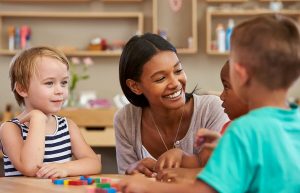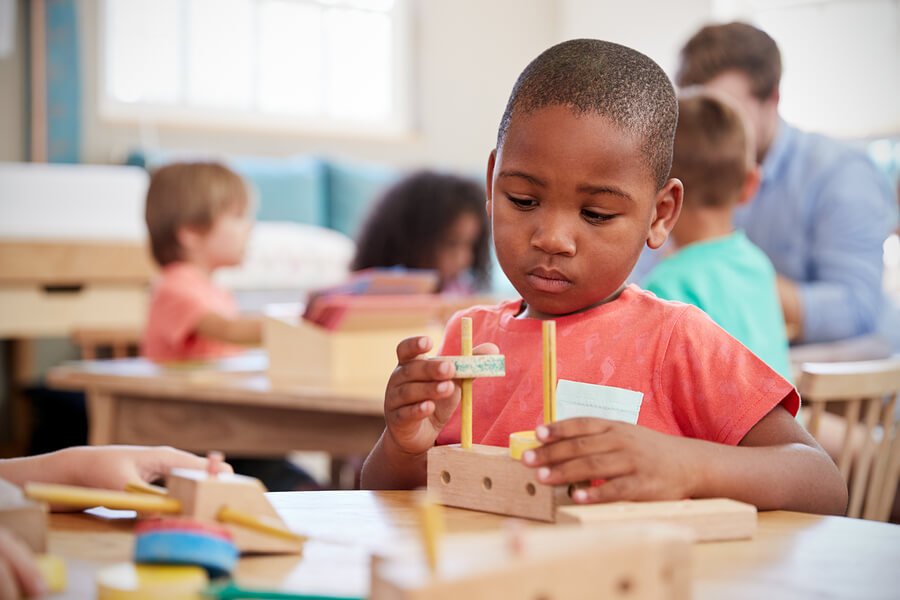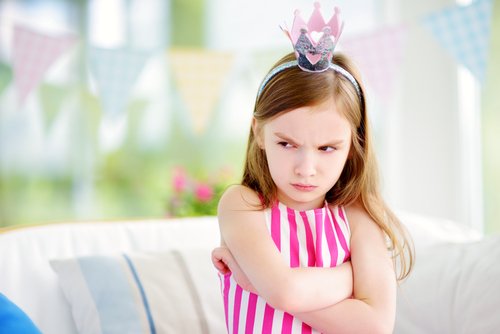Peace Tables: What Are They?

Peace tables come in handy when stressful situations and conflicts arise among children. Peace tables are a space to relax, as well as overcome tension, nervousness and anger. We’ll show you how to make and apply them.
Created by the famous Italian pedagogue and scientist Maria Montessori, peace tables are one of the many Montessori resources to help children grow.
Montessori left such a great legacy behind that her educational methods are being used all over the world today.
How to build peace tables
First of all, you need to decide where to make the table to help your children relax. It should be a place they can easily access when they need to calm down or express their feelings.
Also, you need to think about the materials that you’ll need. In addition to the basics, which include a small table and two chairs, you can add these things:
- Decorations: Plants, paintings, or other similar elements can give it a personal touch.
- Books: There need to be some books related to expressing feelings. Also, you can include other books you and your children like.
- Musical instruments: Instruments can be very beneficial. They can be relaxing and help children think more clearly.
- Bells: Children can ring the bell when they feel better.

Should I let children use them on their own?
An important point is that making kids use these tables won’t work well. This is especially true if you try to use peace tables negatively as a form of punishment.
Instead, invite your children to use this table when they want to. It needs to be a voluntary space.
Also, children need to have access to the table for whenever they need it. They should want to use the tables because they know they’ll help them overcome their problems.
When is it appropriate to use peace tables?
They can be necessary in lots of different circumstances. For example, it’s useful if your children feel frustrated, anxious, angry, sad or worried. Introduce the table as a place to relax, think about other things, and let go of negative emotions.
On the other hand, it can also be useful if your children have a negative experience. They could have fought with their siblings or friends or got a bad grade at school.
The main benefit of peace tables is that they help kids calm down. Then, they’re ready to talk to their parents about whatever is bothering them.
After spending time there, children will have a more positive outlook. They’ll be more receptive to explanations and conversations.
If they’re fighting with siblings, you can have them all sit at the peace table. Once there, they can take turns holding an object that gives them the right to talk. You can also use a timer for this.
Of course, mediation is essential for this meeting. If you mediate properly, you’ll see that peace tables can be a great resource. They’re great for conflict resolution.

Benefits of using peace tables
From all of this, we can conclude that peace tables are very advantageous for children. Some of the biggest benefits are that kids can:
- Recognize and internalize their own and others’ emotions. They encourage emotional intelligence.
- Learn how to communicate and express themselves. They learn how to do this when they’re stressed or upset.
- Learn how to be assertive and negotiate when they communicate.
- Improve self-esteem. This is because the children learn that they’re able to solve their own problems.
- Promote healthy interaction with other children.
Finally, it’s important to emphasize that every child is unique. Not all children will get used to peace tables so easily.
Therefore, it’s ideal to simply encourage them to give it a try. It works better if you make it appealing instead of forcing them.
Once they use it, peace tables will be a very enjoyable private space. Work with them to decorate it. Take the opportunity to share beautiful moments together!
Peace tables come in handy when stressful situations and conflicts arise among children. Peace tables are a space to relax, as well as overcome tension, nervousness and anger. We’ll show you how to make and apply them.
Created by the famous Italian pedagogue and scientist Maria Montessori, peace tables are one of the many Montessori resources to help children grow.
Montessori left such a great legacy behind that her educational methods are being used all over the world today.
How to build peace tables
First of all, you need to decide where to make the table to help your children relax. It should be a place they can easily access when they need to calm down or express their feelings.
Also, you need to think about the materials that you’ll need. In addition to the basics, which include a small table and two chairs, you can add these things:
- Decorations: Plants, paintings, or other similar elements can give it a personal touch.
- Books: There need to be some books related to expressing feelings. Also, you can include other books you and your children like.
- Musical instruments: Instruments can be very beneficial. They can be relaxing and help children think more clearly.
- Bells: Children can ring the bell when they feel better.

Should I let children use them on their own?
An important point is that making kids use these tables won’t work well. This is especially true if you try to use peace tables negatively as a form of punishment.
Instead, invite your children to use this table when they want to. It needs to be a voluntary space.
Also, children need to have access to the table for whenever they need it. They should want to use the tables because they know they’ll help them overcome their problems.
When is it appropriate to use peace tables?
They can be necessary in lots of different circumstances. For example, it’s useful if your children feel frustrated, anxious, angry, sad or worried. Introduce the table as a place to relax, think about other things, and let go of negative emotions.
On the other hand, it can also be useful if your children have a negative experience. They could have fought with their siblings or friends or got a bad grade at school.
The main benefit of peace tables is that they help kids calm down. Then, they’re ready to talk to their parents about whatever is bothering them.
After spending time there, children will have a more positive outlook. They’ll be more receptive to explanations and conversations.
If they’re fighting with siblings, you can have them all sit at the peace table. Once there, they can take turns holding an object that gives them the right to talk. You can also use a timer for this.
Of course, mediation is essential for this meeting. If you mediate properly, you’ll see that peace tables can be a great resource. They’re great for conflict resolution.

Benefits of using peace tables
From all of this, we can conclude that peace tables are very advantageous for children. Some of the biggest benefits are that kids can:
- Recognize and internalize their own and others’ emotions. They encourage emotional intelligence.
- Learn how to communicate and express themselves. They learn how to do this when they’re stressed or upset.
- Learn how to be assertive and negotiate when they communicate.
- Improve self-esteem. This is because the children learn that they’re able to solve their own problems.
- Promote healthy interaction with other children.
Finally, it’s important to emphasize that every child is unique. Not all children will get used to peace tables so easily.
Therefore, it’s ideal to simply encourage them to give it a try. It works better if you make it appealing instead of forcing them.
Once they use it, peace tables will be a very enjoyable private space. Work with them to decorate it. Take the opportunity to share beautiful moments together!
All cited sources were thoroughly reviewed by our team to ensure their quality, reliability, currency, and validity. The bibliography of this article was considered reliable and of academic or scientific accuracy.
- Díaz Mora, S. E. (2016). Diseño de una propuesta metodológica para el uso de la mesa de la paz a partir de la solución de conflictos en el kínder La Casa de los Niños Montessori de El Carmen de Cartago, durante el año 2016 (No. 005073 TFG). SE Díaz S.,.
- Santerini, M. (2013). Grandes de la educación: María Montessori. Padres y Maestros/Journal of Parents and Teachers, (349). https://revistas.comillas.edu/index.php/padresymaestros/article/view/959
- COGNITIVO, E. D. D. (2018). método Montessori. http://www.educa.jcyl.es/crol/es/recursos-educativos/metodo-montessori.ficheros/1402046-METODO_MONTESSORI.pdf
This text is provided for informational purposes only and does not replace consultation with a professional. If in doubt, consult your specialist.








